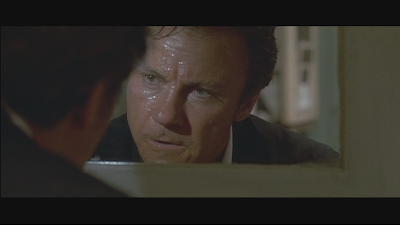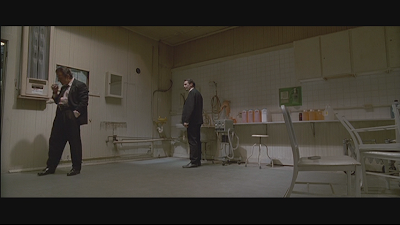I wrote this for another website a couple years ago, but it took a lot of work so I'm going to post it here as well. Apologies if you've already read it.
Reservoir Dogs is a brilliant piece of filmmaking, a cheap, theatrical genre film that overcomes its limitations in location variety through masterful camerawork while simultaneously playing with the conventions of the heist film. The opening sequence is justly famous, with its gangsters having breakfast while arguing over the true meaning of "Like A Virgin" (prior movie gangsters would never admit to listening to Madonna) and whether or not to tip waitresses (the kind of mundane issue raised to importance through grandiose dialogue stylization that would become Tarantino's trademark). But the third scene, I think, serves to show just how subtly effective Tarantino's direction can be. There are many things to talk about in this film, but this scene struck me on watching it again, so I'd like to look at it in detail, if you'll indulge me.
It starts just after Mr. Pink has arrived at the rendez-vous. He and Mr. White head to the back to wash up and try and reconstruct what happened at the heist. First, we have a long shot of Mr. White framed by a hallway. We're distant from him (still wanting to linger with the quite dramatic Mr. Orange), and Mr. Pink is off-screen ranting. Isolating Mr. White leads us to privilege his POV over that of Mr. Pink:
This shot is held for several minutes, broken up by Keitel's anxious walks to the doorway in the middle distance (to check on Mr. Orange), and finally by Mr. Pink's entrance from behind the wall:
This setup only changes when Mr. White lights their cigarettes, leading us to a medium two-shot (slightly offcenter, with Pink pushing White to the edge of the frame befitting his agressive behavior) of the two of them arguing. From now on, we'll be more concerned with their argument than the condition of Mr. Orange.
This setup is broken up by a flashback showing Mr. Pink's escape from the police:
But soon, we're back in the warehouse in a closer balanced shot:
Pink moves away, back and to the right, opening up the room into the first master shot we get, a low angle, diagonal shot with White in the far back corner and Pink in the right foreground:
Tarantino then sets up a shot/reverse shot pattern, but one that is not deteremined by the characters' POVs, but instead an alternating series of closer shots from the POV of an offscreen observer:
Note that the cuts here do not correspond to whoever is talking, as in most Hollywood films. Throughout this scene, as much dialogue is offscreen as it is on, with the camera lingering on the non-speaking actor as much as the histrionic one.
Anyway, the alternating shots continue for awhile, with the cutting getting more rapid as Mr. Pink pulls out and checks his gun:
Eventually, Pink gets up and approaches White, which we see from the same master shot, this time unbalanced with both charcters in the background:
Then we cut axially to a closer version of the same shot:
And back out again:
This time, White walks off to the left, while Pink stays in place, setting up a new shot/reverse shot sequence:
The cut here is very smooth. Offscreen, Pink says "I got the diamonds". We see White whril around to face him, and then cut to Pink:
And back to White:
Who walks into Pink's frame for a congratulatory twoshot:
A reverse cut is followed by White moving back to his previous position, with a slight camaera movement to recreate the framing of the inital shot/reverse shot setup:
Cut to Pink, now twisted to almost face the camera:
He rotates and the camera reframes as White moves to the mirror on the back wall:
White paces back and forth, and with the mention of an undercover cop, we cut back to the master shot:
And back to the previous shot (its not really shot/reverse shot, but it is the third pair of alternating shots in the scene):
As they begin to argue over who the rat is, White turns and faces Pink, giving us a slightly off-balance two shot with both characters fighting for the middle of the frame:
And again out to the master:
Pink exits to the left, and White is again alone in the distance, echoing the opening shot of the sequence and transitioning into his flashback (complete with title card).
Thus is a ten minute sequence consistenting of nothing but expository dialogue (no pop culture references, no jokiness) rendered consistently interesting. The characters are framed unconventionally, but in ways that tell us about who they are and what they're thinking not with POV shots, but in their spatial relations within the frame. The editing is unconventional as well, avoiding contemporary Hollywood methodology while also mixing various styles for dramatic effects (long takes, quick cuts, choosing not to cut when simply moving characters is as effective). In all, Tarantino uses the full repertoire of classical Hollywood filmmaking (think Hawks and Curtiz) in a way few of his peers can manage, with their fast-cutting disregard for either spatial relations or the more elegant ways of utilizing mise-en-scene in favor of dueling over-the-shoulder shots.
The movie, of course, has many other things going for it aside from good direction. The performances, for the most part are excellent, with Keitel bringing a poignancy to his character's relationship with Mr. Orange that's unusually tender for a gangster film, balanced with his own brooding solidity. This is also possibly Buscemi's best performance, the one where his natural weasliness is most balanced by a believable agressiveness (this is the only time he's been the least bit imposing, physically). Michael Madsen, of course, comes close to stealing the film as the psychotic Mr. Blonde, and Lawrence Tierney and Chris Penn are terrific as the father and son gangsters. There's even a guy who sounds exactly like, but is definitely not, Samuel L. Jackson.







































No comments:
Post a Comment